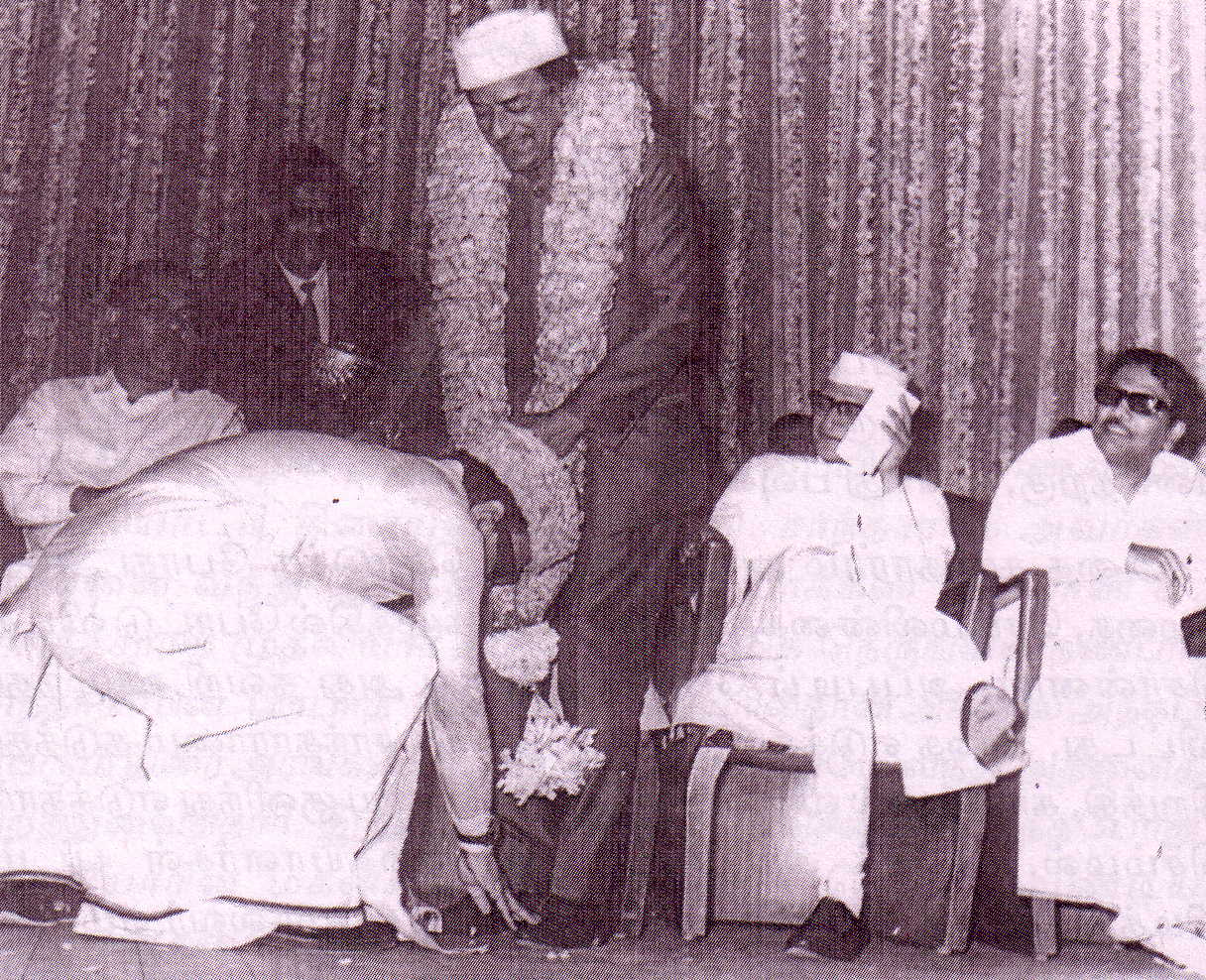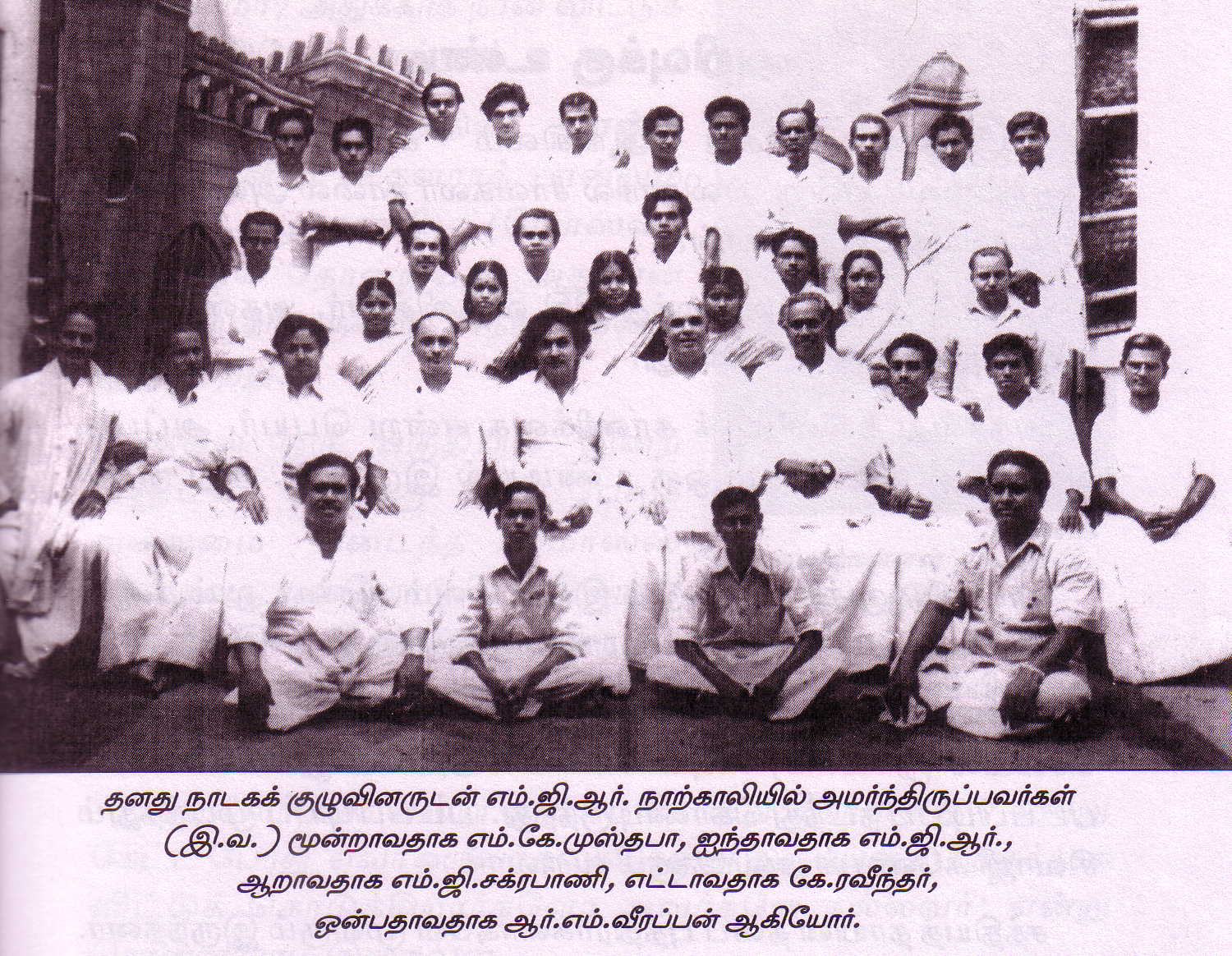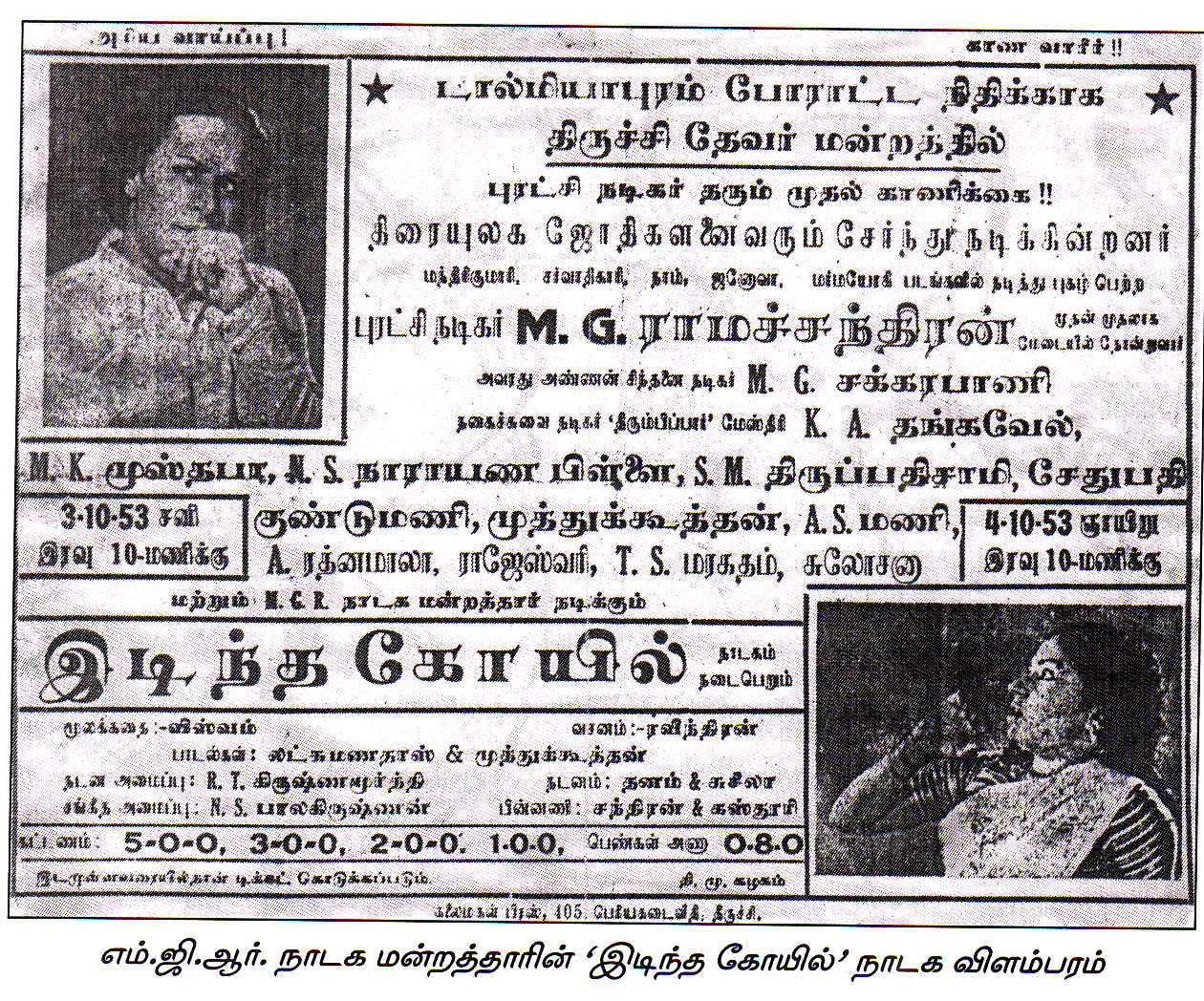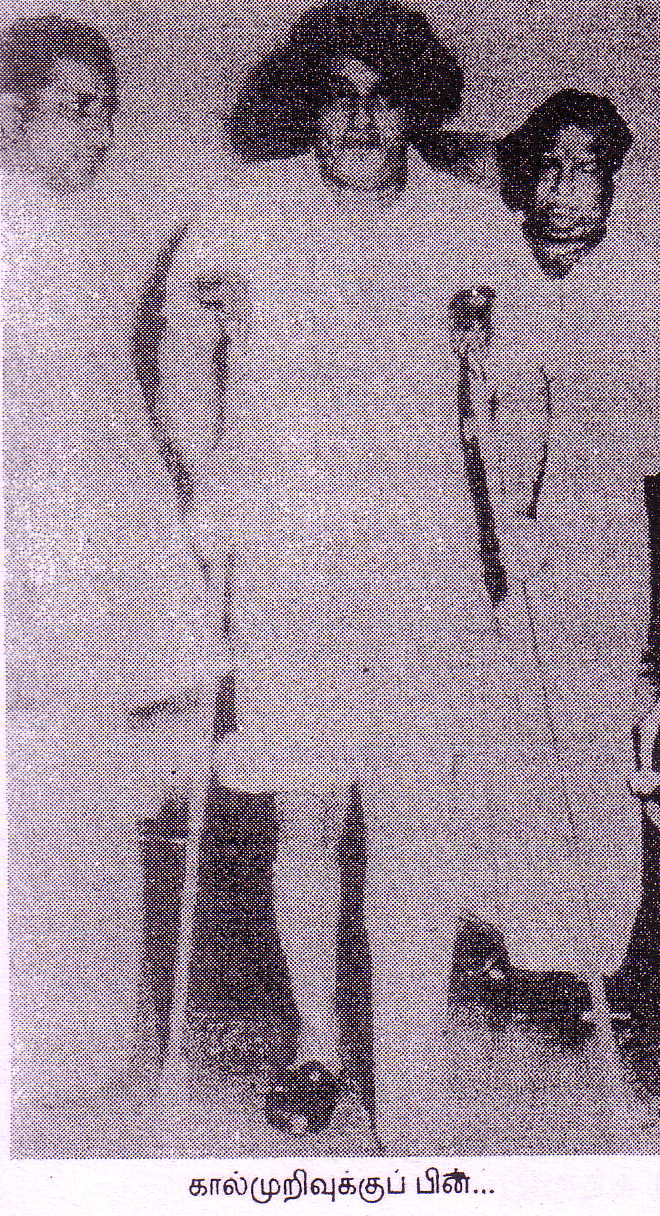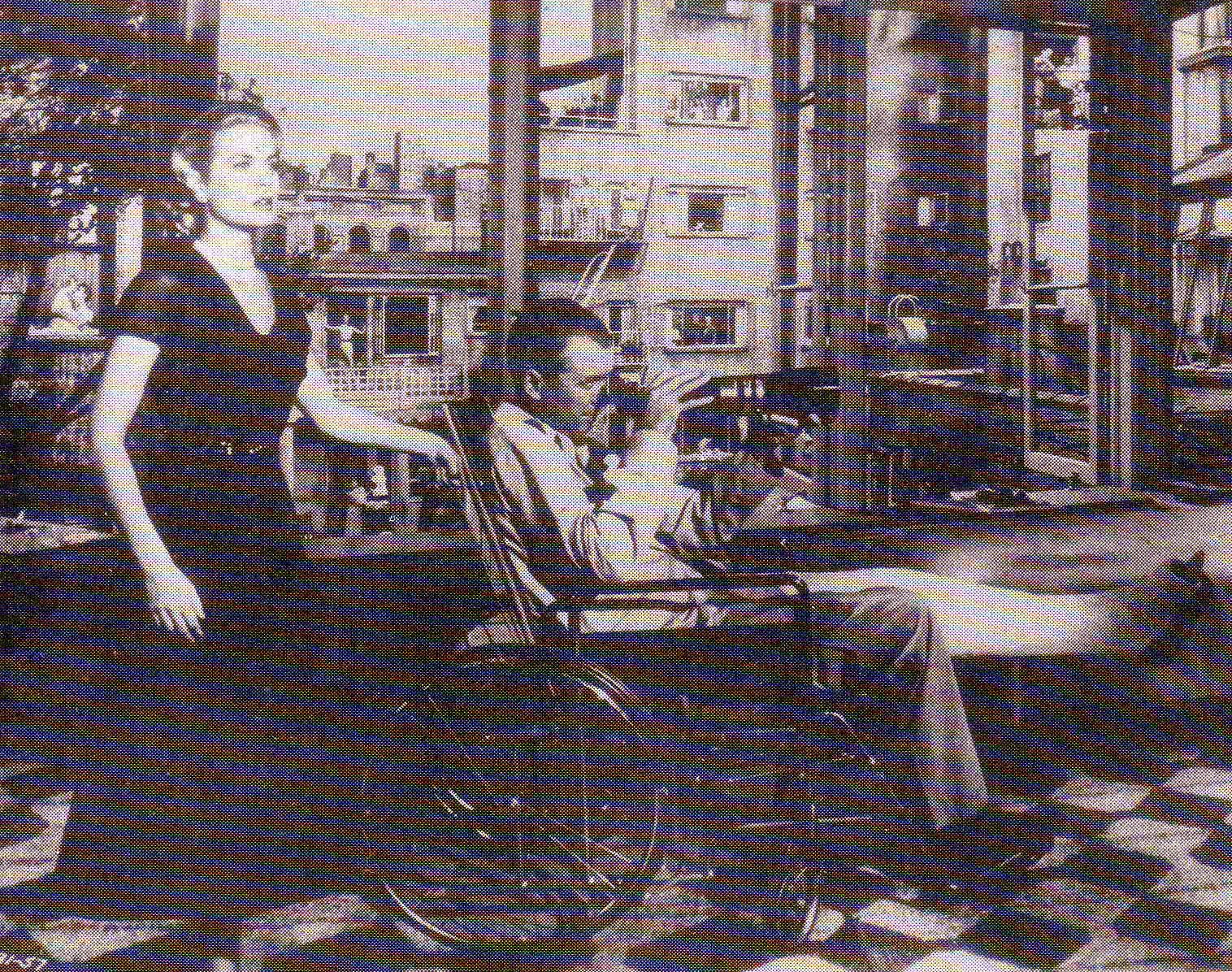by Sachi Sri Kantha, December 22, 2013
Thoughts of Three Readers
I provide the thoughts of three readers of this series, and my responses to them. In an email that I received on Nov.8, a reader Manickam Miller from Chennai wrote the following:
“Your details and non-traditional perception of things interested me. I have a lot of interest in Tamil cinema and want to work on setting up a Tamil cinema archives a la Margaret Herrick Library.
I enjoy MGR Remembered thoroughly because it talks about him as an earthly mortal with heavenly qualities. Almost all the writers who had written about MGR so far made him either a God or a Satan. The wonderful life of MGR is still not explored in the right perspective and it is a duty to take him to the next generation. Your writing is a good sign. Thanks.”
In a subsequent email of Nov.13th, the same reader wrote, “And MGR touching the feet of somebody in public is very rare. So far there are only two such instances have been known or recorded. One is M.K. Radha which you have mentioned, and another is director V. Shantaram.”
I’ll comment on this director V. Shantaram episode shortly.
The second reader R. Kannan (about whose MGR-affiliated interests I had mentioned in part 12) wrote the following in his email of Nov. 9th. I provide only excerpts here:
“I particularly liked the introduction of your piece; I like your argument and find it persuasive. It is not clear to me why some felt that MGR was older by a few years. Your research is fascinating: listing all those MGR called annan and extrapolating his age. Just as a word of caution though it is quite customary that because of one’s social standing one who is younger might sometimes be
addressed as annan at least in Tamil Nadu! As an aside
MGR used to address those he liked as andavane and mudhalali.”
The pet dimunitives MGR used to address those he liked, as indicated in his last sentence by Kannan, can be loosely translated as ‘God’ and ‘Boss’. My response to Kannan’s thought were in the email I sent to him on Nov. 11th. Relevant excerpts were,
“I do agree your point that kinship term ‘Annan/Anne’ could be used to a chronologically younger guy, based on social standing. There is one instance of that, in MGR’s autobiography. MGR mentions at one location that N.S.Krishnan (NSK) used to call M.K.Radha (MKR), as ‘Annan’, though chronologically NSK was few years senior to MKR.
While reading MGR’s autobiographies, I also noticed another point. He doesn’t address other chronologically elder artistes to him (such as T.S. Balaiah, S.V. Sahasranamam and Krishnan of Krishnan-Panju director duo) as ‘Anne’. May be, he was not so close to them, like the 14, I had identified in part 12.”
The third reader Arul Pandian from California wrote the following in his email of Dec.3rd: “I read your latest MGR article. Even though you have convincingly proved that 1917 is his birth year, it is hard for me to accept that he died at a relatively young age of 70 compared to the still living corpse Karunanidhi.” To this reader, my response was as follows,
“Regarding MGR’s death at age 70, one cannot ignore the fact that entertainers (actors, singers, and musicians) overall have a relatively shorter life span, because of the risks (personal and professional) they take in their careers and also for the energy they dissipate for their performances. So, it’s apt that MGR and Sivaji Ganesan had a relatively short life span. I’m also amazed to see quite a number of my favorite actors and singers (such as T.S. Balaiah, S.V. Subbiah, T.R. Mahalingam, Sirkazhi Govindarajan) died in their 50s or after barely reaching 60.”
The episode of MGR bending in front of director V. Shantaram
MGR’s writing assistant Ravindar (aka Kaja Muhaideen) had recorded this episode for posterity. I provide a translation below as well as that particular photo nearby.
“After MGR became the Chief Minister of Tamil Nadu, he invited Shantaram for a special function and honored him. For that function, he presented Shantaram with a chain made of nine sovereigns. This is because Shantaram had previously produced an unusual movie titled, ‘Navrang’.[Navam (in Sanskrit) = nine]
When it was handed to Shantaram, he had requested MGR to garland him with it. During that action, the chain had accidentally fell down. When both bent down to pick it, MGR stopped Shantaram and he himself picked the fallen chain that had landed in front of Shantaram’s legs. This particular scene was snapped by some photographers, and the next day the caption for that photo appeared as, MGR received blessing from Shantaram by bending down. After reading this report, MGR commented, ‘Even if I received such blessing, I’d be more than happy. There is no shame in receiving such blessing from elders who are above us. It shows that humility is a wonderful trait to possess.’
When one checks that particular photo, we notice that in the dais, to the left of Shantaram, Morarji Desai (then the prime minister) and M. Karunanidhi were seated. Even though, he was the chief minister, MGR had invited and accommodated Karunanidhi (who was then the Leader of the Opposition of Tamil Nadu Legislative Assembly) for that particular function.
One Difference between John Wayne and MGR
In Parts 10 and 11 of this series, I had compared the movie careers of MGR and John Wayne. One vital difference between their careers deserves notice. While MGR had a strong background in stage drama before his entry into movies, John Wayne lacked such a background. John Wayne was unique for his generation, in not having such a stage background, whereas other leading Hollywood heroes such as Spencer Tracy, Anthony Quinn, Kirk Douglas, Jason Robards Jr.,
James Stewart, Henry Fonda and Marlon Brando had it.
MGR had a total of nearly 18 years (from ~1924 to 1936 and from ~1953 to 1959) of stage experience, between the ages 7 to 42. Though he entered movie industry in 1936 and elevated his career from a bit player to the hero rank in 1947, once he established himself as a hero, he set up his own drama troupe. This was a fashion of those times. Many of his seniors and contemporaries in the Tamil movies did manage drama troupes. These include, N.S. Krishnan, S.V. Sahasranamam (both MGR’s seniors) as well as K.R. Ramasamy, Sivaji Ganesan, S.S. Rajendran, R.S. Manohar and K.A. Thangavelu. Many reasons can be cited for movie actors managing their own drama troupes, of which vanity maybe one. Some like Manohar (though playing the villain role in movies) could act as a hero his own drama production and satisfy their ego and gain fame with the fans. Another reason could be, to feel the pulse and sentiments of the patronizing common folks directly without intermediaries and formulating viable movie plots of the day. An additional reason could be to identify and promote new talents for movies. One such surprising ‘find’ by MGR was comedian Ceiyur Krishna Gundu Rao (aka C.K. Nagesh), though he was not a member of MGR drama troupe. This had been acknowledged by Nagesh himself, in his autobiography.
A scan of MGR’s autobiographical memoirs reveals that majority of its 134 chapters were related to MGR’s life time experience in stage drama in Tamilnadu of 1920s and 1930s. In a couple of instances, he touches the 1940s (before he became a movie hero in 1947), such as suggesting revision to a script on warrior king Sivaji penned by his later mentor Anna. In 1950s, MGR had formed his own drama troupe. Towards this focus, he had hired two script writers (namely K. Ravindar and Vidwan V. Lakshmanan in 1953 and 1954). But excluding a few chapters and a couple of names, MGR hardly mentions about the composition of his drama troupe in his autobiographical memoirs. Only exception: a career threatening injury that he suffered at the staging of his drama in 1959.
In his memoirs, Ravindar had included a couple of photos (MGR drama troupe members and the bill for 1953 announcement of the troupe drama ‘Idintha Koyil’ (Demolished Temple). These I
provide here, in scans. The bill indicates the roster of actors and specifically mentions that MGR will appear in stage ‘for the first time!’ after his hero stints in movies, Manthirikumari, Sarvadhikari, Naam, Genoa and Marma Yogi. Some actors listed, apart from MGR had already gained a footing in movies, such as MGR’s elder sibling M.G. Chakrapani, K.A. Thangavelu (comedian), M.K. Mustapha and Muthukoothan (a lyricist).
A head count of the MGR drama troupe photo indicates 36 individuals, including five women. MGR and his elder sibling were seated in (bench or chair) the first row in the middle, 5th and 6th respectively from the left. Relative to his brother, MGR had noticeable black scalp hair, while his brother had a thinning whitish hair. Script writer Ravindar is seated 8th from the left, and R.M.Veerappan (later to become another trusted MGR hand in movies and politics) is seated 9th from the left.
Snippets of Stage Drama Career in his Autobiographical Memoirs
I provide below translations of MGR’s recording of his stage experiences, in translation. In chapter 48, under the caption ‘Internal and External’, he wrote,
“Nearly 25 years ago [note by Sachi: probably around 1946], I got an opportunity to act in a drama ‘Karppin Vetri’ (Victory for Chastity), scripted by Mr. R. Venkatasalam. The character I played was that of a young man who promoted an idea that was not then accepted by the society. He was of good character; not under the influence of any negative individuals; he himself was without any bad habits. He loved a woman; both were bound by feelings, sentiments and policy. He promoted the idea that ‘tying the thaali (holy knot) is superstitious; having a life contract is rational’. Those sentiments were accepted by his bride too. But when I acted that character in front of many folks at the stage, as scripted by the playwright, what I received was only ridicule, anger and resentment.
This was the sentiments of that period. Folks who rejected the thought and phrase ‘life contract’ then, were the same who accepted when such life contracts and registered marriages were held later under the guidance of leaders.”
In chapter 55, under the caption ‘Mental Struggle’, MGR had described his premonition about the accident that he would face on June 16, 1959. Here is the translation, of this particular chapter.
“I established the ‘MGR Drama Troupe’ and conducted it for a few years. As I plan to describe my experiences received in such a venture later, I mention here only the relevant episode.
It was about the drama to be staged in Sirkazhi. In previous days, the same drama was staged in Peravoorani and ThirukaddupaLLi. As usual I woke in the morning – but on that particular day I was in disturbed mind and for a long time I was seated in by bedding. Friends came to inquire. If there was anything special, then I could answer them. Only, when pal Thirupathi asked me separately, I told him my concern. ‘My mind is troubled. I don’t know why. I guess, a big accident is about to happen. To whom? How? Where? This I don’t know.’ He comforted me, ‘As you were acting in a conflict-concerned role, you might have slept with those thoughts. That’s why you are troubled like this.’
‘I’m not dreaming; I felt this, while I was awake’, I told him. Somehow, I made up my mind to leave for Sirkazhi.
I told driver Sekhar: ‘Be careful in driving. For any reason, our car shouldn’t meet with any accident.’ Why I mentioned this, was the scare that had settled in my mind that somehow an accident is waiting. He also drove the car sensibly. We reached Sirkazhi in the evening. There was light rain dribbles.
As the drama was to be staged in open air, if it rains, it had to be cancelled. Yes, on that day, my mind was not settled for acting. If one asks why, I cannot answer. Somehow, the drama should not take place. That was my wish [on that day]. When it rained, I felt pleased, and mentally satisfied. But, mother nature didn’t permit me to revel on that pleasure. The rain had stopped. If drama was cancelled, income loss results for us as well as the drama organizer. I wasn’t bothered about that, in my mood of that day…
Near the make-up room, I was lying in a bench. Actors and actresses were getting ready. My brother came and asked, ‘What’s bad?’ I replied, ‘Mentally feeling unwell. Not in a mood to act.’ Around that time, four guys brought an immense-sized garland, carrying in a bamboo pole – like how they carry a [dead] pig. When I saw it, I asked, ‘To whom this garland is?’
‘It’s for you’ they retorted. ‘Specially made with flowers that won’t wilt. We had hung it in the flower shop for two days, for people to admire.’ They mentioned this with pride. Without thinking, I quipped instantly with speed, ‘I will not wear this. It seems like a one which is offered to the God.’ They thought that I’m joking, and with a smile in their face, had hung it in a nearby bamboo pole, which was placed for dresses.
Though how much I liked that drama to be cancelled on that particular day, it did commence quickly. Drama was staged. In a fight scene, my leg broke (I’ll describe the details later.) Drama was stopped. What I feared about this accident from the morning of that day, did happen to me. It didn’t happen to others and luckily to me! I returned with a broken leg and a big question mark about my [professional] future.”
Leg Injury in 1959
The anti-climax to MGR’s stage career occurred in June 16, 1959. While staging the drama ‘Pleasant Dream’ at Sirkazhi, MGR was supposed to raise a heavy-build actor Kundumani (approximately 300 kg body wight) in an action scene. He had accidentally stepped into a hole in the stage, and Kundumani had carelessly fell directly onto MGR’s left leg. As such, left tibia had broken instantly. The drama on that day was stopped as a result of such a serious accident. Those who had attended, especially the women fans, could only cry. MGR could only offer solace to his fans that he would stage the same drama after recuperation from injury.
After returning to Madras, orthopedics specialist Rama Rao was consulted and he made serious
efforts to rebuild MGR’s damaged left tibia. Assistant Ravindar had recorded what happened next. While the rumor spread in Madras studios and in the print media, that MGR’s movie career had come to an abrupt end, he found it difficult to stay in leg cast for weeks. He had considered as a penance. To spend time wisely in recuperation, MGR bought a 16 mm projector and with the help of projector operator Padmanaban, watched movies daily. One of the movies that attracted his attention was the 1954 Hitchcock classic, ‘Rear Window’ featuring James Stewart. In it, Jimmy Stewart had offered a superb performance with a leg cast. MGR became interested in adopting such a story and suggested to Ravindar to compose a story so that he could act with leg cast and make it a fresh beginning for his movie career.
That was the period that trough trolley and micro zoom were introduced in India and with the help of photography technician R.R. Chandran, MGR thought of setting the scenes in a room. However, his elder brother Chakrapani and family doctor P.R. Subramaniam had put a stop for such a movie venture.
Decision to Control the Story plots of his Movies
Ravindar also had recorded the following fundamental thoughts of MGR (which I have highlighted in italics below) in his memoir. Few of the movies starring MGR that were released after his leg injury were unsuccessful at box office. These included, Thai Magalukku Kattiya Thaali (‘A Thaali tied by mother to her daughter’, released on Dec.31, 1959, produced and directed by R.R.Chandran), and Raja Desingu (‘King Desingu’, released on Sept.2, 1960, produced by Lena Chettiar and directed by T.R. Ragunath). It appears that MGR was hurt by the box office failure of Thai Magallukku Kattiya Thaali, which had his mentor Annadurai’s story plot, and scripted by another DMK literateur Rama Arangannal. Ravindar records, that one critic had offered a verdict ‘shame’ for this movie. When this was brought to MGR’s notice, he commented, “Anyone has the right to criticize. When someone criticize you, one should check whether we have such a defect, and then correct ourselves. If this is not so, one should bring this to the critic’s attention. We should accept our faults with open heart, and reject such criticism when the critic is wrong. This should be one’s life lesson.”
MGR also did accept the criticism fairly for this movie. “As there are 12 organs in a body, this movie business also has 12 organs. One who can comprehend the functions of all organs should direct a movie. If a specialist who handles one particular aspect of a movie, becomes a director, he would focus his attention only on his speciality, and ignores other vital aspects. The director of this Thai Magalluku Kattiya Thaali movie, R.R. Chandran, was a specialist cinematographer. His focus was only on camera. As such, he had ignored other vital aspects of the movie.” was MGR’s verdict.
MGR was obliged to producer S.M. Letchumanan Chettiar (Lena Chettiar), a remarkable personality in Tamil movie world from 1930s to 1950s. Randor Guy had written repeatedly about the exploits of this producer in his regular ‘Blast from the Past’ series. For such references, see the sources listed below. Lena Chettiar had produced the successful MGR starrer Madurai Veeran (‘Hero of Madurai’, released in 1956). It was a popular folk story, and a rare MGR movie in which the protagonist dies at the end (true to the folk story). The script for the movie was written by poet Kannadasan. However, MGR had disagreement with the producer in placing a well-received dance scene/song featuring Padmini, according to an insider view presented by ‘Film News’ Anandan. Though MGR had opposed this scene/song being included in the movie, the producer had overruled MGR and had inserted the scene/song according to his wish. The script formulation for Raja Desingu (‘The king Desingu’), a subsequent movie produced by the same producer Lena Chettiar, was not to MGR’s liking, though the latter didn’t antagonize the producer this time. Again, the script writer for the movie was poet Kannadasan. Both Madurai Veeran and Raja Desingu had double heroines, namely P. Bhanumathi and Padmini. Temperamental differences MGR had developed with heroine Bhanumathi’s cooperation during the production of his own movie Nadodi Mannan (Vagabond King, released in 1958) as well as budding political differences with Kannadasan (who was on the verge of deserting DMK party), might have also affected the successful completion of Raja Desingu before release.
Ravindar also records that, even another movie Madapura (‘Balcony Pigeon’, released on Feb. 16, 1962, produced by B. Vallinayagam and directed by S.A.Subburaman) did not have a
successful run, as expected. Thus, MGR came to a determined decision on selecting his future movie projects. His coherent view was that, “One shouldn’t bend to the wishes of the producer. The story plot should be ideal. If it is not so, one should demand the right to re-structure the story plot.” This became his prime focus to deliver successful, crowd-pleasing movies. MGR’s logic was, “One can work with those who know everything. One can also work with those who don’t know anything. But, one shouldn’t work with those who know nothing, but pretends to know everything.”
Sources
Film News Anandan: Sadhanaigal padaitha Thamizhthiraipada Varalaru (Tamil Film History and its Achievements), Sivagami Publications, Chennai, 2004, p. 29-85[in Tamil].
Randor Guy: Blast from the Past – Prabhavathi (1942). The Hindu, Chennai, Dec. 10, 2011.
Randor Guy: Blast from the Past – Marumagal (1953). The Hindu, Chennai, Dec. 22, 2012.
Randor Guy: Blast from the Past – Kaveri (1959). The Hindu, Chennai, Oct. 20, 2013.
MGR: Naan Yen Piranthaen [Why I was Born?], Rajarajan Pathipakam, Chennai, 2003. Part 1 (696 pages), Part 2 (697-1396 pages). [in Tamil]
K. Ravindar: Pon Mana Chemmal MGR [Golden Hearted MGR], Vijaya Publications, Chennai, 2009, pp. 104-105. [in Tamil].
